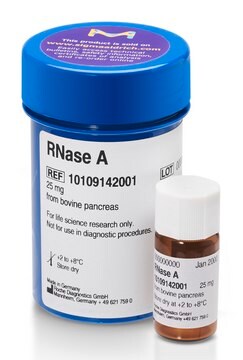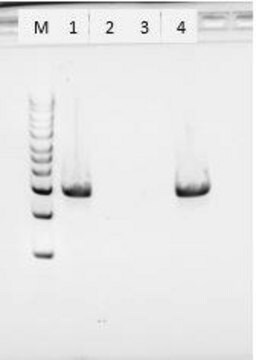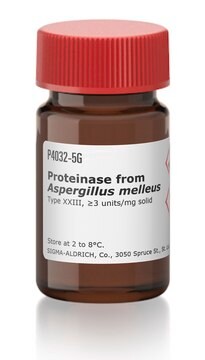RPROTKSOL-RO
Roche
Protéinase K, recombinante, de qualité PCR
Solution from Pichia pastoris
Se connecterpour consulter vos tarifs contractuels et ceux de votre entreprise/organisme
About This Item
Produits recommandés
Produit recombinant
expressed in Pichia pastoris
Niveau de qualité
Forme
buffered aqueous solution (18 ± mg/mL; pH 7.5)
Activité spécifique
~2.5 units/mg protein
Conditionnement
pkg of 1.25 mL (03115887001)
pkg of 25 mL (03115844001)
pkg of 5 mL (03115828001)
Fabricant/nom de marque
Roche
pH optimal
6.5 and 9.5
Plage de pH
4.0-12.5
Température de stockage
2-8°C
Description générale
Environ 2,5 U/mg (dosage Chromozym) ; ≥ 30 U/mg (dosage hémoglobine). Pour connaître les valeurs spécifiques d'un lot, veuillez vous référer au certificat d'analyse.
Application
- This PCR grade Proteinase K is extremely effective on native proteins and can therefore be used to rapidly inactivate endogenous nucleases such as RNases and DNases. This property makes Proteinase K particularly suitable for the isolation of native RNA and DNA from tissues or cell lines.
- The enzyme promotes cell lysis by activating a bacterial autolytic factor.
- Proteinase K is also used for the analysis of membrane structures by modifying proteins and glycoproteins on cell surfaces.
- The enzyme is particularly well suited for isolating nucleic acids for amplification reactions.
Caractéristiques et avantages
↓ The enzyme is extremely effective on native proteins and can therefore be used to rapidly inactivate endogenous nucleases such as RNases and DNases.
- Choose an effective tool for template preparation. Inactivate DNases and RNases of most species.
- Count on consistent quality and performance. Stringent quality testing ensures optimal stability and high-level lot-to-lot performance.
- Prepare samples over a wide range of conditions. The robust enzyme is stable over a wide pH range and is ideal for diverse applications.
- Benefit from a contamination-free enzyme. The enzyme is tested for the absence of RNases and DNases, and is virtually free of DNA. It is especially suited for the isolation of PCR templates.
Qualité
This preparation is free of RNases, DNases, and DNA, according to the current quality control procedures.
Absence of Nucleases: Each lot is tested on various substrates to ensure the absence of endonuclease, exonuclease, ribonuclease, and nicking activity.
Teneur en ADN : ≤10pg/mg enzyme (determined by Threshold)
Biocharge : ≤5cfu/g (determined by the most stringent test from the European Pharmacopoeia, which identifies the total number of viable aerobic bacteria, yeast, and fungi)
Absence of Nucleases: Each lot is tested on various substrates to ensure the absence of endonuclease, exonuclease, ribonuclease, and nicking activity.
Teneur en ADN : ≤10pg/mg enzyme (determined by Threshold)
Biocharge : ≤5cfu/g (determined by the most stringent test from the European Pharmacopoeia, which identifies the total number of viable aerobic bacteria, yeast, and fungi)
Définition de l'unité
Activité volumique : Approximately 50 U/ml solution (chromozyme assay); approximately 600 U/ml solution (hemoglobin assay). One unit is the enzyme activity which cleaves at +25 °C in 1 min 18 mmol Chromozym TRY (equivalent to 600 U/ml with the hemoglobin assay). Refer to the Certificate of Analysis for specific values for the present lot.
Notes préparatoires
Activateur : To stimulate proteinase K activity, denaturing agents (SDS and urea) can be added. For example, SDS at a final concentration of 2% can increase the activity of proteinase K significantly. Optimization using denaturing agents can increase proteinase activity by as much as sevenfold.
Solution de travail : Tampons suggérés :
The most appropriate buffer for Proteinase K will vary from application to application. Always follow the pH and temperature guidelines in parameter filed. As a general rule, proteinase K is stable and very active in buffers that contain denaturing reagents such as urea, sodium dodecyl sulfate (SDS), and guanidinium salts.
Inhibiteurs: ® However, it is not inactivated by metal ions, chelating agents (e.g., EDTA), sulfhydryl reagents, or trypsin and chymotrypsin inhibitors.
Solution de travail : Tampons suggérés :
The most appropriate buffer for Proteinase K will vary from application to application. Always follow the pH and temperature guidelines in parameter filed. As a general rule, proteinase K is stable and very active in buffers that contain denaturing reagents such as urea, sodium dodecyl sulfate (SDS), and guanidinium salts.
Inhibiteurs: ® However, it is not inactivated by metal ions, chelating agents (e.g., EDTA), sulfhydryl reagents, or trypsin and chymotrypsin inhibitors.
Autres remarques
For the rapid inactivation of RNases and DNases.
The enzyme can reduce protein to free amino acids if it is present in large excess for long incubation periods.
The enzyme can reduce protein to free amino acids if it is present in large excess for long incubation periods.
Pour la recherche en sciences de la vie uniquement. Ne pas utiliser dans des procédures de diagnostic.
Informations légales
Pefabloc is a registered trademark of Pentapharm
Mention d'avertissement
Danger
Mentions de danger
Conseils de prudence
Code de la classe de stockage
12 - Non Combustible Liquids
Classe de danger pour l'eau (WGK)
WGK 1
Point d'éclair (°F)
No data available
Point d'éclair (°C)
No data available
Faites votre choix parmi les versions les plus récentes :
Déjà en possession de ce produit ?
Retrouvez la documentation relative aux produits que vous avez récemment achetés dans la Bibliothèque de documents.
Les clients ont également consulté
Sungjae Hwang et al.
Cancer, 119(24), 4249-4258 (2013-10-12)
Epigenetic reprogramming of the methylome has been implicated in all stages of cancer evolution. It is now well accepted that cancer cells exploit epigenetic reprogramming, a mechanism that regulates stem/progenitor cell renewal and differentiation, to promote cancer initiation and progression.
Gerard Honig et al.
Journal of biomedical science, 17, 82-82 (2010-10-19)
Multicellular organisms are characterized by a remarkable diversity of morphologically distinct and functionally specialized cell types. Transgenic techniques for the manipulation of gene expression in specific cellular populations are highly useful for elucidating the development and function of these cellular
Shari Carmon et al.
Development (Cambridge, England), 148(24) (2021-12-18)
Morphogen gradients are known to subdivide a naive cell field into distinct zones of gene expression. Here, we examine whether morphogens can also induce a graded response within such domains. To this end, we explore the role of the Dorsal
Jian Zhang et al.
BMC developmental biology, 8, 115-115 (2008-12-18)
RNA-binding motif protein 19 (RBM19, NCBI Accession # NP_083038) is a conserved nucleolar protein containing 6 conserved RNA recognition motifs. Its biochemical function is to process rRNA for ribosome biogenesis, and it has been shown to play a role in
Caroline Meyer Olesen et al.
Microorganisms, 9(7) (2021-08-08)
Investigation of changes in the skin microbiome following treatment of atopic dermatitis (AD) with dupilumab may provide valuable insights into the skin microbiome as a therapeutic target. The aim of this study is to assess changes in the AD skin
Notre équipe de scientifiques dispose d'une expérience dans tous les secteurs de la recherche, notamment en sciences de la vie, science des matériaux, synthèse chimique, chromatographie, analyse et dans de nombreux autres domaines..
Contacter notre Service technique









